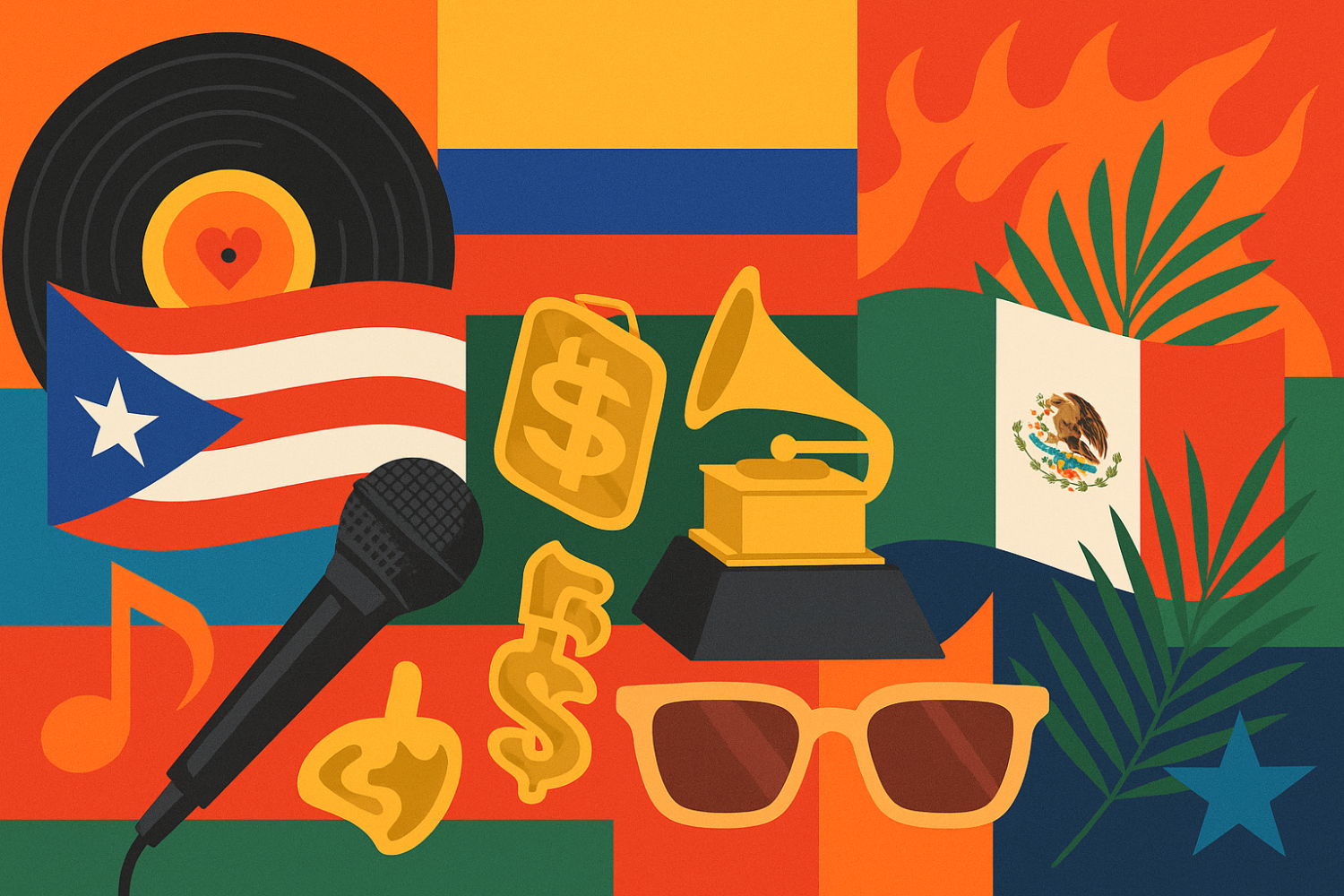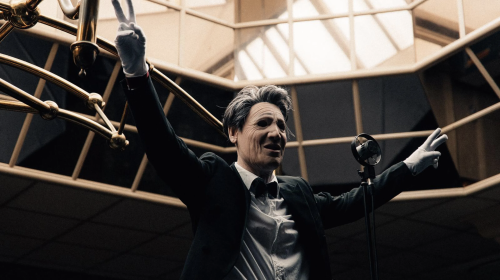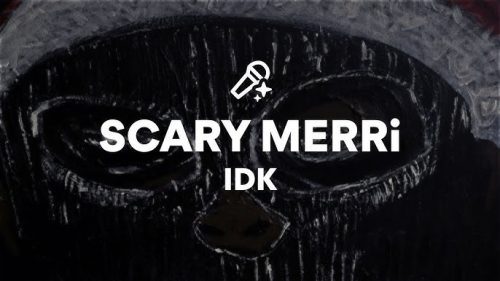Latin artists are not just having a moment, they’re continuing a legacy of shaping the sound of global music. From Puerto Rico to Spain, Colombia to Argentina, and Mexico to Brazil, Latin artists are blending reggaetón, R&B, trap, funk, and traditional sounds into something that crosses borders and languages. The result? An unstoppable wave of rhythm, storytelling, and energy that’s impossible to ignore.
Over the past few years, the Latin music industry has redefined what it means to be a pop artist, a rapper, an artist. Latin artists are breaking records, headlining festivals, and inspiring new generations with sounds that mix authenticity and innovation. If you’re new to Latin music or deep into the scene, these 20 current Latin arists are singers and rappers that you need to add on your radar in 2025.
The Global Rise of Latin Artists
Bad Bunny remains the face of the modern Latin artists and the latin music revolution. Born Benito Antonio Martínez Ocasio in Bayamón, Puerto Rico, and raised in Vega Baja, he first caught attention on SoundCloud with “Soy Peor” in 2016. His career exploded with the 2018 hit “I Like It” alongside Cardi B and J Balvin, and he’s since become Spotify’s most-streamed artist multiple years running. Albums like X 100PRE, YHLQMDLG, Un Verano Sin Ti, and Debí Tirar Más Fotos reflect a visionary who blends Latin trap, reggaeton, punk, and political consciousness. With three Grammys, eleven Latin Grammys, and a headlining slot at the 2026 Super Bowl, Bad Bunny continues to represent both Puerto Rican pride and global artistry.
Colombia’s J Balvin stands as another pillar of modern Latin artists and culture. Born José Álvaro Osorio Balvín in Medellín, he chased his musical dreams from the U.S. back to Colombia, shaping the sound of global reggaeton with hits like “Mi Gente,” “Ginza,” and “Ay Vamos.” Known for his bold style and bright aesthetic, Balvin’s work on albums like Energía, Vibras, and Colores solidified him as an international crossover success. Beyond his 11 Billboard Latin Music Awards and 6 Latin Grammys, Balvin’s influence reaches into fashion and mental health advocacy, blending creativity and consciousness in every move.
Another Colombian powerhouse, Karol G, has redefined the image of women as Latin artists. Born Carolina Giraldo Navarro in Medellín, she began singing at 14 and broke through with “Ahora Me Llama” featuring Bad Bunny in 2017. Her albums Unstoppable, Ocean, and KG0516 propelled her to global fame, earning her collaborations with Nicki Minaj, Anuel AA, and Shakira. With empowering tracks like “Tusa,” “Bichota,” and “Provenza,” Karol G embodies strength and sensuality, earning her Grammy and Latin Grammy wins and multiple Guinness World Records. She’s not just a Latin artist — she’s a movement.
From San Juan, Puerto Rico, Ozuna helped usher in the melodic side of reggaeton. Born Juan Carlos Ozuna Rosado, he started writing songs at 12 before emerging with “La Ocasion” in 2016. His albums Odisea, Aura, and Nibiru produced hits like “Se Preparó,” “Baila Baila Baila,” and “Te Vas.” Known for his smooth vocals and romantic touch, Ozuna has two Latin Grammys, 11 Billboard Latin Music Awards, and a massive fan base worldwide. As he preps for another world tour, Ozuna remains one of reggaeton’s most consistent and respected hitmakers.
Anuel AA, another Puerto Rican trailblazer, has helped shape the sound of Latin trap. Born Emmanuel Gazmey Santiago in Carolina, Puerto Rico, his early success with “Sola” and albums like Real Hasta La Muerte, Emmanuel, and Las Leyendas Nunca Mueren showcased his gritty storytelling and emotional transparency. With collaborations alongside Karol G, J Balvin, and Ozuna, Anuel AA continues to balance street authenticity with mainstream appeal, earning multiple Billboard Latin Music Awards and cementing his status as a pioneer of the Latin trap movement.
You can’t mention Latin music without acknowledging the godfather of reggaeton — Daddy Yankee. Born Ramón Luis Ayala Rodríguez in San Juan, he turned “Gasolina” into a global anthem in 2004 and brought reggaeton from the streets to the stadiums. Albums like Barrio Fino, El Cartel: The Big Boss, and Prestige defined an era. With countless awards and cultural milestones, Daddy Yankee’s influence is permanent. Even in retirement, his impact on the genre — and on generations of Latin artists — remains unmatched.
From the same city that produced so many greats, Maluma represents Colombia’s suave and romantic side. Born Juan Luis Londoño Arias in Medellín, he first gained fame with “Borró Cassette” in 2015. His albums Pretty Boy, Dirty Boy, F.A.M.E., and 11:11 delivered worldwide hits like “Felices los 4,” “Hawái,” and “Chantaje.” Collaborating with Shakira, Madonna, and Ricky Martin, Maluma has built a Latin pop empire grounded in charisma and crossover appeal. His ventures now stretch into fragrance, fashion, and philanthropy — a true global brand.
Nicky Jam’s journey has been one of resilience and reinvention. Born Nick Rivera Caminero in Lawrence, Massachusetts, he moved to Puerto Rico as a child and became one of reggaeton’s early stars before facing setbacks that nearly ended his career. His comeback with “El Perdón,” “Hasta el Amanecer,” and “El Amante” made him an icon once again. Albums like Fénix and Íntimo reflect that redemption arc, earning him Latin Grammys and Billboard honors while inspiring millions through both his music and story.
Don Omar, one of reggaeton’s foundational figures, remains a legend. Born William Omar Landrón Rivera in Villa Palmeras, Puerto Rico, his early albums The Last Don and King of Kings turned songs like “Danza Kuduro” and “Virtual Diva” into global hits. Known for his deep voice and fusion of genres, Don Omar has earned multiple Latin Grammys and continues to tour and collaborate with the next wave of artists. His legacy bridges the old-school roots of reggaeton with its global present.
From Panama, Sech brought a new wave of romantic reggaeton to the world. Born Carlos Isaías Morales Williams, he rose from local rap battles to international fame when “Otro Trago” became one of Latin music’s biggest hits of 2019. Albums like Sueños, 1 of 1, and 42 showcase his melodic approach and lyrical vulnerability. Working with artists like Daddy Yankee, J Balvin, and Rosalía, Sech has earned Billboard honors and helped put Panama’s urban music scene on the global map.
Puerto Rico’s Rauw Alejandro represents the genre’s futuristic edge. Born Raúl Alejandro Ocasio Ruiz, he blends reggaeton, R&B, and pop with an unmatched sense of rhythm and movement. Songs like “Todo de Ti,” “Tattoo,” and “Desenfocado” have made him one of the most exciting performers of the last decade. Albums such as Afrodisíaco, Vice Versa, and Playa Saturno reveal his sonic versatility, and his collaborations with Rosalía, Anuel AA, and J Balvin continue to push Latin music forward.
Feid, another key figure from Medellín, Colombia, has carved out his own lane. Born Salomón Villada Hoyos, he started producing his own music before collaborations with J Balvin and Maluma brought him into the spotlight. With albums like Así Como Suena, Inter Shibuya, and Ferxxo Vol X: Sagrado, Feid’s style merges reggaeton, trap, and pop into a sound that’s both underground and mainstream. He’s become one of Medellín’s defining Latin artists of this generation, building a global following with each release.
From Añasco, Puerto Rico, Young Miko represents the new face of Latin trap. Born María Victoria Ramírez de Arellano Cardona, she began as a tattoo artist before becoming one of the most talked-about rappers in the Latin world. Her EP Trap Kitty (2022) and feature on Bad Bunny’s “Fina” brought her international attention, followed by hits like “Classy 101,” “Gata Sin Puder,” and “Culo.” With her debut album Att. and collaborations with Feid and Villano Antillano, Young Miko’s fearless authenticity and openly queer identity are breaking barriers for women and LGBTQ+ artists in Latin music.
From Mexico, Peso Pluma has bridged regional Mexican sounds with the urbano movement. Born Hassan Emilio Kabande Laija in Guadalajara, his corridos tumbados and hits like “Ella Baila Sola,” “PRC,” and “Rosa Pastel” made him one of the most streamed Latin artists worldwide. His album Efectos Secundarios and collaborations with Natanael Cano and Junior H highlight the fusion of tradition and modernity that defines his rise. Peso Pluma’s success proves that Latin music’s reach now extends far beyond reggaeton — it’s everything from trap to traditional.
Argentina’s TINI has mastered the art of reinvention. Born Martina Stoessel in Buenos Aires, she first rose to fame on Disney’s Violetta before becoming one of Latin pop’s biggest stars. With albums like TINI, Quiero Volver, and Cupido, she’s delivered hits including “Miénteme,” “La Triple T,” and “Cupido.” Collaborating with Sebastián Yatra, María Becerra, and Morat, TINI continues to lead Argentina’s new generation of Latin artists.
María Becerra, another star from Argentina, has quickly become one of the most streamed voices in Latin music. Born in Quilmes, she started with YouTube covers before transitioning into trap and R&B. Her breakthrough collaboration with TINI on “Miénteme” and albums Animal and La Nena de Argentina proved her staying power. With hits like “Automático” and “Corazón Vacío,” Becerra’s emotional authenticity and genre-blending make her one of the most promising young artists in Latin pop.
Becky G, born Rebbeca Marie Gomez in Inglewood, California, bridges two worlds — American and Latin. She began posting covers on YouTube and transitioned from English pop to Spanish hits like “Mayores” and “Sin Pijama.” Her albums Mala Santa and Esquinas blend bilingual storytelling with undeniable swagger. As one of the most visible U.S.-born Latin artists, Becky G continues to collaborate with names like Maluma and Bad Bunny while empowering fans through music and activism.
From Rosario, Argentina, Nicki Nicole brings an R&B-infused edge to Latin trap. Born Nicole Denise Cucco, she gained fame through her viral Bizarrap session and hasn’t looked back since. With hits like “Wapo Traketero,” “Colocao,” and “No Toque Mi Naik,” and albums Recuerdos and Parte de Mí, Nicki Nicole stands as one of Latin America’s most authentic voices. Her blend of soul, trap, and pop continues to resonate globally.
Spain’s Lola Indigo closes the circle, representing Europe’s connection to the Latin music wave. Born Miriam Doblas Muñoz in Madrid, she transitioned from Operación Triunfo contestant to one of Spain’s most electrifying performers. With hits like “Ya No Quiero Ná,” “Mala Suerte,” and “AN1MAL,” and albums Akelarre and La Niña, Lola Indigo fuses dance-pop energy with reggaeton-inspired rhythms, bringing Spanish flair to the Latin global stage.
These 20 Latin artists show the diversity, creativity, and cultural richness of today’s Latin music scene. From established stars like Bad Bunny, J Balvin, and Daddy Yankee to rising talents like Young Miko and Peso Pluma, each artist brings their unique voice, style, and story to a global audience.
We celebrate all artists who break barriers, represent their culture, and redefine music for new generations, but something just hits different with latin artists these past few years.
Following these latin artists is not just about listening to catchy tunes—it’s about experiencing the heartbeat of Latin urban culture, witnessing innovation, and supporting a movement that continues to influence the world.







